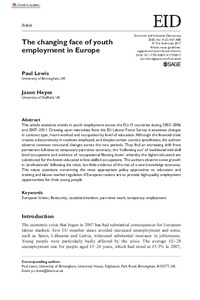The changing face of youth employment in Europe

Economic and Industrial Democracy
2020
41
2
May
457-480
employment ; labour force ; young worker ; educational level
Employment
https://doi.org/10.1177/0143831X17720017
English
Bibliogr.;Charts;Statistics
"This article examines trends in youth employment across the EU-15 countries during 2002–2006 and 2007–2011. Drawing upon microdata from the EU Labour Force Survey it examines changes in contract type, hours worked and occupation by level of education. Although the financial crisis creates a discontinuity in numbers employed, and despite certain country specificities, the authors observe common structural changes across the two periods. They find an increasing shift from permanent full-time to temporary part-time contracts, the ‘hollowing out' of traditional mid-skill level occupations and evidence of ‘occupational filtering down' whereby the higher-educated are substituted for the lower-educated in low-skilled occupations. The authors observe some growth in ‘professionals' following the crisis, but little evidence of the rise of a new knowledge economy. This raises questions concerning the most appropriate policy approaches to education and training and labour market regulation if European nations are to provide high-quality employment opportunities for their young people."
Digital
The ETUI is co-funded by the European Union. Views and opinions expressed are however those of the author(s) only and do not necessarily reflect those of the European Union or the ETUI.